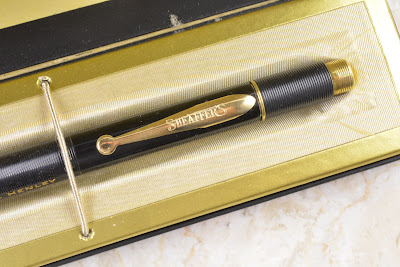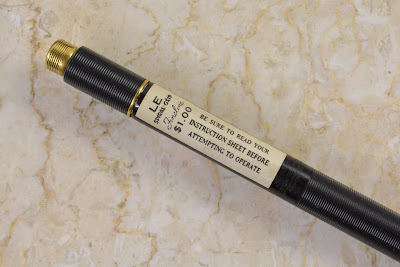This article has been edited and included in The Leadhead's Pencil Blog Volume 5; copies are available print on demand through Amazon here, and I offer an ebook version in pdf format at the Legendary Lead Company here.
If you don't want the book but you enjoy this article, please consider supporting the Blog project here.
It’s baseball Opening Day today . . . the earliest opening day since 1968, and the first time all thirty teams in the league are playing on Opening Day. So as “maybe next year” turns into “maybe this year,” this seemed like an appropriate thing to share with you today:
George Rimakis brought it for me to the fDC show a few yearrs back, and it gave me a chuckle in two ways. First, I just love cheesy Americana, and it just doesn’t get more American than baseball. Second, I got a kick out of the fact that George, who typicaly dwells in the realm of the super-serious, super expensive and super-important historical writing instruments, would see something as goofy as this, think of me, and pick it up thinking I’d like it.
And like it I do! The pencil and dip pen set is for the Cleveland Indians, which we here in Ohio annually think will be able to get the job done every spring, odds and past history notwithstanding (except in years when the Reds are doing well. Here in Columbus, smack dab in between the two, metropolis on the lake and the one on the river, we tend to sway either way --
when I was growing up in the mid-70s, it was the Big Red Machine and back-to-back World Series Championships in ‘74 and ‘75 that had the capital city looking south for its summertime thrills rather than north. But the Indians have been doing well fairly consistently for the last twenty years, so maybe this will be Ohio’s year.
So there’s my first little prayer for Cleveland - that for the first time in seventy years, the last time they won the Series in 1948, that we might see souvenirs that say what these do:
And my second prayer is for a bit of sanity. Note that the Indian logo on this set is an ordinary profile of a Native American in a headdress, not the cartoony, toothy-grinned Chief Wahoo that was adopted as the team’s logo in 1950. Our Indians will appear without an officially sanctioned Chief Wahoo this year, now that dim-witted social justice warriors have finally intimidated the team into believing their logo, worn so proudly for more than half a century, is racist, exploitative or any number of other vile things.
As Humpty Dumpty said to Alice, we can make words mean whatever we want them to mean, and the same can be said for how anyone wishes to perceive something as harmless as Chief Wahoo. So my other little prayer for Cleveland is that the pendulum of political correctness is approaching or has finally reached its apex, and those who are inclined to be offended can finally be at peace with the notion that being offended is only a choice rather than a reaction in the absence of any concerted effort to offend.
If Chief Wahoo represented a Native American as something less worthy than others – as something that was somehow athletically, morally, culturally or in any way empirically inferior to any other group – I have one question for any snowflakes who might be reading this:
Why would our players and fans want to wear it so proudly?
The vast majority of people in my part of the world, taking Humpty Dumpty’s cue, have chosen to see Chief Wahoo as a symbol of indomitable and optimistic spirit, with a broad smile that accurately reflects our joy and love of a game, even in the face of annual disappointment come every October.
I will miss our friend Chief Wahoo, defeated not on the diamond but by forces who have chosen to have him mean something entirely different. There’s no question he’ll live on, as fans will continue to don his likeness – whether it be out of sentimentality, respect, fond rememberance, or rebellion against the tyranny of a sliver of a minority who thinks they have the right to tell us what to think and what we can and cannot say. Unfortunately, he is in danger now of becoming a symbol not of our simple hope for a great season of baseball, but a cause celebre for narrow-minded socialists igniting more dischord over something so silly.
I know I’m on my soapbox, and I’m done. If this article offended you, feel free to change the channel and demand your money back for having read it.
And Go Tribe! Oh wait, am I still allowed to say “tribe?”


















































